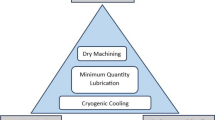Abstract
The problem of the combined usage of surface and chemically-active additives within metalworking fluids (MWF) for edge-cutting processing has been studied. The test results of MWFs containing surface-active additives with oxygen-containing reactive components have been demonstrated. The hypothesis of the special structure of boundary lubrication layers formed by two triboactive components of different chemical nature has been defined.
Access this chapter
Tax calculation will be finalised at checkout
Purchases are for personal use only
Similar content being viewed by others
References
Godlevskiy VA, Markov VV (2004) Synergic interaction of superficial- and chemically-active metalworking fluids components. Mater Int Sci Conf SLOVIANTRIBO-6. St. Petersburg, vol 2, pp 41–46 (in Russian)
Latyshev VN, Markov VV (1974) The peroxyde substances application as metalworking fluids. Mach Technol 10:6–12 (in Russian)
Williams JA, Tabor D (1977) The role of lubricants in machining. Wear 43(3):275–292
Godlevskiy VA, Latyshev VN, Volkov VV, Maurin LN (1997) The kinetics of lubricant penetration action during machining. Lubr Sci 9(2):127–140
Astakhov VP, Godlevskiy VA, Joksch S et al (2012) Metalworking fluids for cutting and grinding: fundamentals and recent advances. Woodhead Publishing Ltd., Cambridge, UK, 413 p
Latyshev VN (1985) Increasing of metalworking fluids effectivity. Mashinostrojenije, Moscow, 65 p (in Russian)
Mizuhara K (1992) Experimental evaluation of cutting fluid penetration. Tribologia 11(2):20–29
Godlevskiy VA, Markov VV, Volkov AV (2009) Description of surface active lubrication materials action at edge cutting with model of mono-molecular adsorption. In: Liquid crystals and their practical application, vol 3, pp 61–66 (in Russian)
Kostetskiy BI, Natanson ME, Bershadskiy LI (1972) Mechano-chemical processes during boundary friction. Nauka, Moscow, 214 p (in Russian)
Berezina EV, Godlevskiy VA, Latyshev VN et al (1995) To the mechanism of phthalocyanine derivatives solutions lubrication action at metal cutting processes. Izvesija AN RF. Physical series, vol 59(3), pp 161–165 (in Russian)
Berezina EV, Godlevskiy VA, Usoltseva NV (2007) Phenomena of supramolecular self-organization in boundary lubrication layer. In: Friction and lubrication in machines and mechanisms, vol 4, pp 30–36 (in Russian)
Godlevskiy VA, Berezina EV, Volkov AV, Zheleznov AG, Fomichev DS (2015) On the research technique of mesogene lubrication layer optical properties. In: Lecture notes in mechanical engineering. Springer Int. Publ., Switzerland, pp 7–12
Pletnev MJ (1987) About the interaction nature in a solution of non-ionogenic and ionogenic surfactants mixtures. In: Kolloidny zhurnal, vol 49(1), pp 184–187 (in Russian)
Lazjuk LN (1985) Influence of surface-active COTC on machining of silicon and gallium arsenide. Dissertation … cand. chem. science, Ivanovo, 165 p (in Russian)
Zaslavskiy JS, Zaslavskiy RN (1978) The action mechanism of oils anti-wear additives. Chimija, Moscow, 224 p (in Russian)
Acknowledgements
The work was supported by the Ministry of Education and Science of the Russian Federation (projects # 9.700.2014 and # 4.106.2014K).
Author information
Authors and Affiliations
Corresponding author
Editor information
Editors and Affiliations
Rights and permissions
Copyright information
© 2017 Springer International Publishing AG
About this chapter
Cite this chapter
Godlevskiy, V.A., Markov, V.V., Usoltseva, N.V. (2017). Principle of Compatibility of Heterogeneous Additives in Triboactive Metalworking Fluids for Edge Cutting of Metals. In: Evgrafov, A. (eds) Advances in Mechanical Engineering. Lecture Notes in Mechanical Engineering. Springer, Cham. https://doi.org/10.1007/978-3-319-53363-6_8
Download citation
DOI: https://doi.org/10.1007/978-3-319-53363-6_8
Published:
Publisher Name: Springer, Cham
Print ISBN: 978-3-319-53362-9
Online ISBN: 978-3-319-53363-6
eBook Packages: EngineeringEngineering (R0)



